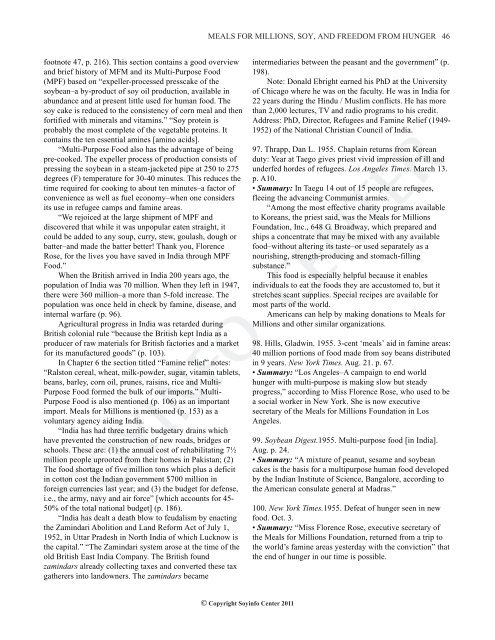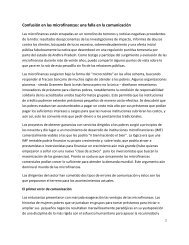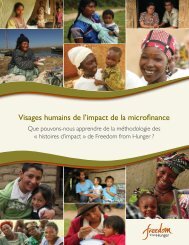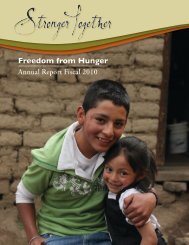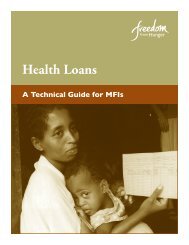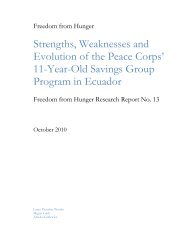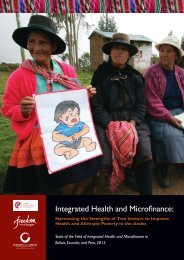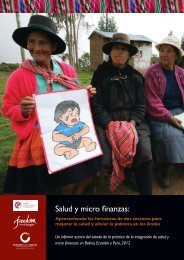history of meals for millions, soy, and freedom from ... - SoyInfo Center
history of meals for millions, soy, and freedom from ... - SoyInfo Center
history of meals for millions, soy, and freedom from ... - SoyInfo Center
Create successful ePaper yourself
Turn your PDF publications into a flip-book with our unique Google optimized e-Paper software.
footnote 47, p. 216). This section contains a good overview<br />
<strong>and</strong> brief <strong>history</strong> <strong>of</strong> MFM <strong>and</strong> its Multi-Purpose Food<br />
(MPF) based on “expeller-processed presscake <strong>of</strong> the<br />
<strong>soy</strong>bean–a by-product <strong>of</strong> <strong>soy</strong> oil production, available in<br />
abundance <strong>and</strong> at present little used <strong>for</strong> human food. The<br />
<strong>soy</strong> cake is reduced to the consistency <strong>of</strong> corn meal <strong>and</strong> then<br />
<strong>for</strong>tified with minerals <strong>and</strong> vitamins.” “Soy protein is<br />
probably the most complete <strong>of</strong> the vegetable proteins. It<br />
contains the ten essential amines [amino acids].<br />
“Multi-Purpose Food also has the advantage <strong>of</strong> being<br />
pre-cooked. The expeller process <strong>of</strong> production consists <strong>of</strong><br />
pressing the <strong>soy</strong>bean in a steam-jacketed pipe at 250 to 275<br />
degrees (F) temperature <strong>for</strong> 30-40 minutes. This reduces the<br />
time required <strong>for</strong> cooking to about ten minutes–a factor <strong>of</strong><br />
convenience as well as fuel economy–when one considers<br />
its use in refugee camps <strong>and</strong> famine areas.<br />
“We rejoiced at the large shipment <strong>of</strong> MPF <strong>and</strong><br />
discovered that while it was unpopular eaten straight, it<br />
could be added to any soup, curry, stew, goulash, dough or<br />
batter–<strong>and</strong> made the batter better! Thank you, Florence<br />
Rose, <strong>for</strong> the lives you have saved in India through MPF<br />
Food.”<br />
When the British arrived in India 200 years ago, the<br />
population <strong>of</strong> India was 70 million. When they left in 1947,<br />
there were 360 million–a more than 5-fold increase. The<br />
population was once held in check by famine, disease, <strong>and</strong><br />
internal warfare (p. 96).<br />
Agricultural progress in India was retarded during<br />
British colonial rule “because the British kept India as a<br />
producer <strong>of</strong> raw materials <strong>for</strong> British factories <strong>and</strong> a market<br />
<strong>for</strong> its manufactured goods” (p. 103).<br />
In Chapter 6 the section titled “Famine relief” notes:<br />
“Ralston cereal, wheat, milk-powder, sugar, vitamin tablets,<br />
beans, barley, corn oil, prunes, raisins, rice <strong>and</strong> Multi-<br />
Purpose Food <strong>for</strong>med the bulk <strong>of</strong> our imports.” Multi-<br />
Purpose Food is also mentioned (p. 106) as an important<br />
import. Meals <strong>for</strong> Millions is mentioned (p. 153) as a<br />
voluntary agency aiding India.<br />
“India has had three terrific budgetary drains which<br />
have prevented the construction <strong>of</strong> new roads, bridges or<br />
schools. These are: (1) the annual cost <strong>of</strong> rehabilitating 7½<br />
million people uprooted <strong>from</strong> their homes in Pakistan; (2)<br />
The food shortage <strong>of</strong> five million tons which plus a deficit<br />
in cotton cost the Indian government $700 million in<br />
<strong>for</strong>eign currencies last year; <strong>and</strong> (3) the budget <strong>for</strong> defense,<br />
i.e., the army, navy <strong>and</strong> air <strong>for</strong>ce” [which accounts <strong>for</strong> 45-<br />
50% <strong>of</strong> the total national budget] (p. 186).<br />
“India has dealt a death blow to feudalism by enacting<br />
the Zamindari Abolition <strong>and</strong> L<strong>and</strong> Re<strong>for</strong>m Act <strong>of</strong> July 1,<br />
1952, in Uttar Pradesh in North India <strong>of</strong> which Lucknow is<br />
the capital.” “The Zamindari system arose at the time <strong>of</strong> the<br />
old British East India Company. The British found<br />
zamindars already collecting taxes <strong>and</strong> converted these tax<br />
gatherers into l<strong>and</strong>owners. The zamindars became<br />
MEALS FOR MILLIONS, SOY, AND FREEDOM FROM HUNGER 46<br />
© Copyright Soyinfo <strong>Center</strong> 2011<br />
intermediaries between the peasant <strong>and</strong> the government” (p.<br />
198).<br />
Note: Donald Ebright earned his PhD at the University<br />
<strong>of</strong> Chicago where he was on the faculty. He was in India <strong>for</strong><br />
22 years during the Hindu / Muslim conflicts. He has more<br />
than 2,000 lectures, TV <strong>and</strong> radio programs to his credit.<br />
Address: PhD, Director, Refugees <strong>and</strong> Famine Relief (1949-<br />
1952) <strong>of</strong> the National Christian Council <strong>of</strong> India.<br />
97. Thrapp, Dan L. 1955. Chaplain returns <strong>from</strong> Korean<br />
duty: Year at Taego gives priest vivid impression <strong>of</strong> ill <strong>and</strong><br />
underfed hordes <strong>of</strong> refugees. Los Angeles Times. March 13.<br />
p. A10.<br />
• Summary: In Taegu 14 out <strong>of</strong> 15 people are refugees,<br />
fleeing the advancing Communist armies.<br />
“Among the most effective charity programs available<br />
to Koreans, the priest said, was the Meals <strong>for</strong> Millions<br />
Foundation, Inc., 648 G. Broadway, which prepared <strong>and</strong><br />
ships a concentrate that may be mixed with any available<br />
food–without altering its taste–or used separately as a<br />
nourishing, strength-producing <strong>and</strong> stomach-filling<br />
substance.”<br />
This food is especially helpful because it enables<br />
individuals to eat the foods they are accustomed to, but it<br />
stretches scant supplies. Special recipes are available <strong>for</strong><br />
most parts <strong>of</strong> the world.<br />
Americans can help by making donations to Meals <strong>for</strong><br />
Millions <strong>and</strong> other similar organizations.<br />
98. Hills, Gladwin. 1955. 3-cent ‘<strong>meals</strong>’ aid in famine areas:<br />
40 million portions <strong>of</strong> food made <strong>from</strong> <strong>soy</strong> beans distributed<br />
in 9 years. New York Times. Aug. 21. p. 67.<br />
• Summary: “Los Angeles–A campaign to end world<br />
hunger with multi-purpose is making slow but steady<br />
progress,” according to Miss Florence Rose, who used to be<br />
a social worker in New York. She is now executive<br />
secretary <strong>of</strong> the Meals <strong>for</strong> Millions Foundation in Los<br />
Angeles.<br />
99. Soybean Digest.1955. Multi-purpose food [in India].<br />
Aug. p. 24.<br />
• Summary: “A mixture <strong>of</strong> peanut, sesame <strong>and</strong> <strong>soy</strong>bean<br />
cakes is the basis <strong>for</strong> a multipurpose human food developed<br />
by the Indian Institute <strong>of</strong> Science, Bangalore, according to<br />
the American consulate general at Madras.”<br />
100. New York Times.1955. Defeat <strong>of</strong> hunger seen in new<br />
food. Oct. 3.<br />
• Summary: “Miss Florence Rose, executive secretary <strong>of</strong><br />
the Meals <strong>for</strong> Millions Foundation, returned <strong>from</strong> a trip to<br />
the world’s famine areas yesterday with the conviction” that<br />
the end <strong>of</strong> hunger in our time is possible.


